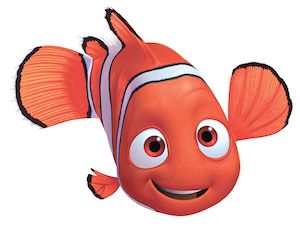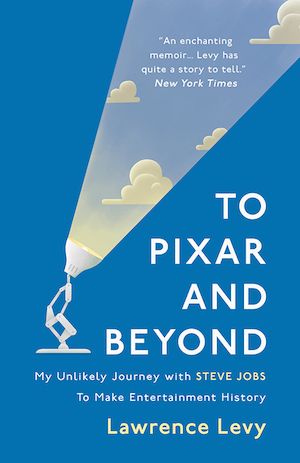To Pixar and Beyond: My Unlikely Journey with Steve Jobs to Make Entertainment History by Lawrence Levy (Oneworld, £18.99)
The story begins in 1994. Lawrence Levy, a tech executive in his thirties, is at home with his wife Hillary discussing his new job. Go and see Steve, she says—tell him your concerns. Cut to exterior, early evening, in the amber light of Old Palo Alto. Levy approaches the entrance to Steve Jobs’s Tudor-style “cottage.” In Jobs’s den the two men mull over Pixar, the tech company Levy has just accepted Jobs’s invitation to run.
Levy is worried: Pixar, founded in 1986, has many promising divisions (advertising, RenderMan graphics software and an unfinished feature film provisionally entitled Toy Story); but no profits even after Jobs has sunk $50m into the company. How can it be viable for Pixar to go public? Would Jobs interfere? Would they be allowed stock options? Meanwhile, Pixar’s distributor Disney is waiting to gobble up or even crush the upstart start-up. Will this be an edgy thriller or will the story end happily, like a feel-good family film?
To Pixar and Beyond, Levy’s memoir of his time heading the most dazzling entertainment studio of our times, has all the twists and turns of one of Pixar’s own films. You will know the films even if you don’t recognise the studio name. Most famously Toy Story, the film that brought an adult sophistication to the animation genre; Finding Nemo (2003), which followed a single-father fish in search of his lost son; and the topsy-turvy Inside Out (2015), a kind of Being John Malkovich for children.
As Levy describes it, the first intimation that Pixar would be saved was in 1995, when hardened Hollywood bankers and lawyers saw an early version of Toy Story. They emerged dazzled and enchanted, though they didn’t initially produce the finance. In just two decades, however, Pixar’s 17 animated films have earned $11bn at the box office and won 13 Academy Awards, eight of them for Best Animated Feature.
Levy’s account of his Pixar years—though he ceased to be an executive in 1999, he remained on the board until the company’s sale in 2006—makes a good companion to Creativity Inc, the bestselling 2014 guide to “overcoming the unseen forces that stand in the way of true inspiration” by Ed Catmull, Co-founder and President of Pixar Animation, now also President of Disney Animation. Between them, they describe elements of Pixar’s particular, inquisitive, adventurous way of working—universally acknowledged as hugely successful.
But is their amazing initial burst of creativity now waning? For how long will they be able to produce masterpiece after masterpiece? Levy observes that “as corporations succeed, they generally become more conservative… Success brings something to defend, something to lose.”
Pixar’s progress has been marked, of course, by restless advances in computer animation, powered by their RenderMan graphics system. In 1986, animator John Lasseter brought to life that most utilitarian of objects, the desk lamp, in a series of short films. (Luxo the lamp still appears in Pixar’s logo.) Then came controlled domestic environments—linear surfaces, plastic toys, artificial lighting, as in the original Toy Story. Then they took their first brave steps into the infinitely varied outdoors: daylight, sky, trees, wind, water, fur, space (Finding Nemo, Monsters Inc, Up and Wall-E). Finally the human face itself, culminating in the kind of photorealism you find in Inside Out that manages to leap across the infamous “uncanny valley”—the theory that digital replicas of human beings, especially accurate ones, inevitably evoke a sense of repulsion in the viewer.
We can compare Pixar’s evolutionary progress with Snow White (1937), Disney’s first fully animated feature. The hand-drawn art-form seemed already fully formed, an act of creationism as it were. Disney continued to improve and refine its work, moving on, for example, to the opening forest sequence of Bambi (1942), in which layers of artwork and a moving camera created an extraordinary depth of field. In the same year David Low in the New Republic hailed Walt Disney as the most significant figure in graphic art since Leonardo da Vinci.
Pixar is Picasso to Disney’s da Vinci. Their animators can shift styles within films to dramatic effect, as in Wall-E or the various regions in a human mind in Inside Out. (In that film the characters at one point are turned into 2D Picasso-like figures, before returning to realism.)
Yet even as their representation of the real reaches closer to perfection—there is a Pixar short about a sea bird, Piper, that in both narrative and visuals has moments almost indistinguishable from a nature documentary—it raises a question. Where does animation stop and live action begin? Few feature films this year have not been digitally manipulated in some way—at the very least for colour correction, but more often to insert background or detail, to tidy up or enhance. The original charm of the animated world has stealthily permeated reality. Does that make animation itself less appealing? Or does the artisan quality of stop-motion (like Tim Burton’s Corpse Bride or American outfit Laika’s Kuboand the Two Strings or Wes Anderson’s Fantastic Mr Fox) become more distinctive in a world where we are surrounded by shiny computer images?
Then again, Pixar’s appeal has never been purely visual. The story is king, says Pixar’s Braintrust, which includes Lasseter (director of Toy Story), Andrew Stanton (Finding Nemo) and Pete Docter (Up and Inside Out). Initially the Braintrust came together as a crisis team to solve specific script problems; over time, it has become a key part of the way the company runs, meeting every few months to assess current projects candidly. It is a system far removed from the old-style studio executive review. Stanton has said that with Toy Story they laid down five tropes to avoid: no songs; no “I want” moment; no happy village song; no love story; no villain. However successful Disney might have been with its fairy-tale retellings and smart musicals like Beauty and the Beast and The Lion King, Pixar wanted to leave behind their perky uniformity for keener observations about the business of living.
In the three Toy Story films Pixar tackled the inevitable passage of time, fear of ageing, redundancy and loss. In Finding Nemo it was parent-child separation, and in its sequel Finding Dory, memory loss and living with disability. Ratatouille’s cordon bleu rat chef struggles with identity and creativity. The robot in Wall-E wrestles in wordless isolation in a dystopia of anachronistic consumerism; his quest is to find beauty among the old junk. And Inside Out, set inside the head of Riley, a girl on the cusp of puberty, boldly introduces ideas about consciousness that nod to developments in neuroscience. More radically, Inside Out conveyed that it was sometimes fine—even necessary—to be sad. “Hakuna Matata” is not a panacea.
Children loved these ambitious films (their parents even more so, perhaps.) The two decades from Toy Story to Inside Out produced an unparalleled range of visual and storytelling daring in mainstream entertainment. But Pixar may find success hard to sustain. Due for release this summer is Cars 3. That’s a bit odd. Cars 2 and Wall-E made comparable box office returns on their budgets—but while the robot film was lauded for its originality, the car-race sequel had mixed reviews. So why is Pixar persisting with the less original of the two films, if not for the merchandising opportunities? Later in the autumn, we will see Coco, a Mexican Day of the Dead story, aimed at a Spanish-speaking demographic. Neither seems, on the face of it, as audacious as a film with an emotion for a protagonist, or an orphaned fish with short-term memory problems.
By 2006, Disney had recognised the dominance of Pixar in the animation market and so bought the company for £4.1bn. There are safeguards in place to ensure the creative separation of the two studios. But the fact that two Pixar men preside over them—Lasseter is CEO and Catmull President, respectively, of both Pixar and Disney Animation Studios—has clearly upped Disney’s game. Frozen neatly skewered the princess myth (while retaining its visual glamour) by having the real love story ultimately prove to be not with a prince but between the royal sisters. Zootopia (or Zootropolis, depending on your side of the Atlantic), the Disney winner of this year’s Oscar for animated feature, was a smart essay on diversity and ambition that conceded (as Pixar’s Monsters University had done before) that sometimes you can’t always be what you want. Ability and aptitude (size even) may get in the way.
It isn’t just Disney that is encroaching on Pixar’s territory. Less commercially dominant studios such as Laika are making visually stunning and thoughtful features (Coraline, Kubo), which tackle ambitious, risky subjects. A recent festival favourite, the Swiss-French stop-motion feature My Life as a Courgette was set in a home for abused children. The future of Japan’s Studio Ghibli, out of which poured Spirited Away and other teeming visions of its founder Hayao Miyazaki, may be in doubt but its dreamy strangeness lingers to remind us how animation reaches across cultures, repurposing western stories with a Shinto inflection.
They will have considered all this at Pixar’s Braintrust. Both Levy and Catmull believe in finding ways beyond business orthodoxy for inspiration. Levy has taken breaks from corporate life to study philosophy and in 2003 co-founded the Juniper Foundation, which teaches Buddhist ways of developing the mind to company teams as well as individuals. Catmull, who has also studied meditation, stresses the importance of paying attention to what’s in front of you rather than hanging on to the past.
Pixar’s creators have always been their own toughest critics. During the production of Toy Story 2 (1999)—which was first devised as a straight-to-video sequel—they struggled with how to follow the success of the first film. After some initial problems, Disney executives pronounced the movie good to go. At that point Pixar called in an early version of the Braintrust, which decided to scrap the whole thing and start from scratch. What was wrong? As Catmull writes in Creativity Inc, the early version of Toy Story 2 was an escape saga with a predictable and not especially moving outcome. Their solution defined the way Pixar would become successful. The characters should face emotional or even moral choices that were fraught with danger. So Andy the cowboy toy (voiced by Tom Hanks) has to decide between intense but finite happiness or longevity. As Catmull puts it, “Would you choose to live forever if it was without love?”
In Wall-E, the danger comes from a robotic autopilot with deadly ambitions who renders human agency redundant. That film cautions against our willingness to hand our destinies over to machines or systems. It was a sharp riposte from a company built on the manipulation of technology. We can trust Pixar to learn the hard lessons from their own films and astonish us all once more. Autopilots they are not.
The story begins in 1994. Lawrence Levy, a tech executive in his thirties, is at home with his wife Hillary discussing his new job. Go and see Steve, she says—tell him your concerns. Cut to exterior, early evening, in the amber light of Old Palo Alto. Levy approaches the entrance to Steve Jobs’s Tudor-style “cottage.” In Jobs’s den the two men mull over Pixar, the tech company Levy has just accepted Jobs’s invitation to run.
Levy is worried: Pixar, founded in 1986, has many promising divisions (advertising, RenderMan graphics software and an unfinished feature film provisionally entitled Toy Story); but no profits even after Jobs has sunk $50m into the company. How can it be viable for Pixar to go public? Would Jobs interfere? Would they be allowed stock options? Meanwhile, Pixar’s distributor Disney is waiting to gobble up or even crush the upstart start-up. Will this be an edgy thriller or will the story end happily, like a feel-good family film?
To Pixar and Beyond, Levy’s memoir of his time heading the most dazzling entertainment studio of our times, has all the twists and turns of one of Pixar’s own films. You will know the films even if you don’t recognise the studio name. Most famously Toy Story, the film that brought an adult sophistication to the animation genre; Finding Nemo (2003), which followed a single-father fish in search of his lost son; and the topsy-turvy Inside Out (2015), a kind of Being John Malkovich for children.
As Levy describes it, the first intimation that Pixar would be saved was in 1995, when hardened Hollywood bankers and lawyers saw an early version of Toy Story. They emerged dazzled and enchanted, though they didn’t initially produce the finance. In just two decades, however, Pixar’s 17 animated films have earned $11bn at the box office and won 13 Academy Awards, eight of them for Best Animated Feature.
Levy’s account of his Pixar years—though he ceased to be an executive in 1999, he remained on the board until the company’s sale in 2006—makes a good companion to Creativity Inc, the bestselling 2014 guide to “overcoming the unseen forces that stand in the way of true inspiration” by Ed Catmull, Co-founder and President of Pixar Animation, now also President of Disney Animation. Between them, they describe elements of Pixar’s particular, inquisitive, adventurous way of working—universally acknowledged as hugely successful.
But is their amazing initial burst of creativity now waning? For how long will they be able to produce masterpiece after masterpiece? Levy observes that “as corporations succeed, they generally become more conservative… Success brings something to defend, something to lose.”
Pixar’s progress has been marked, of course, by restless advances in computer animation, powered by their RenderMan graphics system. In 1986, animator John Lasseter brought to life that most utilitarian of objects, the desk lamp, in a series of short films. (Luxo the lamp still appears in Pixar’s logo.) Then came controlled domestic environments—linear surfaces, plastic toys, artificial lighting, as in the original Toy Story. Then they took their first brave steps into the infinitely varied outdoors: daylight, sky, trees, wind, water, fur, space (Finding Nemo, Monsters Inc, Up and Wall-E). Finally the human face itself, culminating in the kind of photorealism you find in Inside Out that manages to leap across the infamous “uncanny valley”—the theory that digital replicas of human beings, especially accurate ones, inevitably evoke a sense of repulsion in the viewer.

We can compare Pixar’s evolutionary progress with Snow White (1937), Disney’s first fully animated feature. The hand-drawn art-form seemed already fully formed, an act of creationism as it were. Disney continued to improve and refine its work, moving on, for example, to the opening forest sequence of Bambi (1942), in which layers of artwork and a moving camera created an extraordinary depth of field. In the same year David Low in the New Republic hailed Walt Disney as the most significant figure in graphic art since Leonardo da Vinci.
Pixar is Picasso to Disney’s da Vinci. Their animators can shift styles within films to dramatic effect, as in Wall-E or the various regions in a human mind in Inside Out. (In that film the characters at one point are turned into 2D Picasso-like figures, before returning to realism.)
Yet even as their representation of the real reaches closer to perfection—there is a Pixar short about a sea bird, Piper, that in both narrative and visuals has moments almost indistinguishable from a nature documentary—it raises a question. Where does animation stop and live action begin? Few feature films this year have not been digitally manipulated in some way—at the very least for colour correction, but more often to insert background or detail, to tidy up or enhance. The original charm of the animated world has stealthily permeated reality. Does that make animation itself less appealing? Or does the artisan quality of stop-motion (like Tim Burton’s Corpse Bride or American outfit Laika’s Kuboand the Two Strings or Wes Anderson’s Fantastic Mr Fox) become more distinctive in a world where we are surrounded by shiny computer images?
Then again, Pixar’s appeal has never been purely visual. The story is king, says Pixar’s Braintrust, which includes Lasseter (director of Toy Story), Andrew Stanton (Finding Nemo) and Pete Docter (Up and Inside Out). Initially the Braintrust came together as a crisis team to solve specific script problems; over time, it has become a key part of the way the company runs, meeting every few months to assess current projects candidly. It is a system far removed from the old-style studio executive review. Stanton has said that with Toy Story they laid down five tropes to avoid: no songs; no “I want” moment; no happy village song; no love story; no villain. However successful Disney might have been with its fairy-tale retellings and smart musicals like Beauty and the Beast and The Lion King, Pixar wanted to leave behind their perky uniformity for keener observations about the business of living.
In the three Toy Story films Pixar tackled the inevitable passage of time, fear of ageing, redundancy and loss. In Finding Nemo it was parent-child separation, and in its sequel Finding Dory, memory loss and living with disability. Ratatouille’s cordon bleu rat chef struggles with identity and creativity. The robot in Wall-E wrestles in wordless isolation in a dystopia of anachronistic consumerism; his quest is to find beauty among the old junk. And Inside Out, set inside the head of Riley, a girl on the cusp of puberty, boldly introduces ideas about consciousness that nod to developments in neuroscience. More radically, Inside Out conveyed that it was sometimes fine—even necessary—to be sad. “Hakuna Matata” is not a panacea.
Children loved these ambitious films (their parents even more so, perhaps.) The two decades from Toy Story to Inside Out produced an unparalleled range of visual and storytelling daring in mainstream entertainment. But Pixar may find success hard to sustain. Due for release this summer is Cars 3. That’s a bit odd. Cars 2 and Wall-E made comparable box office returns on their budgets—but while the robot film was lauded for its originality, the car-race sequel had mixed reviews. So why is Pixar persisting with the less original of the two films, if not for the merchandising opportunities? Later in the autumn, we will see Coco, a Mexican Day of the Dead story, aimed at a Spanish-speaking demographic. Neither seems, on the face of it, as audacious as a film with an emotion for a protagonist, or an orphaned fish with short-term memory problems.
By 2006, Disney had recognised the dominance of Pixar in the animation market and so bought the company for £4.1bn. There are safeguards in place to ensure the creative separation of the two studios. But the fact that two Pixar men preside over them—Lasseter is CEO and Catmull President, respectively, of both Pixar and Disney Animation Studios—has clearly upped Disney’s game. Frozen neatly skewered the princess myth (while retaining its visual glamour) by having the real love story ultimately prove to be not with a prince but between the royal sisters. Zootopia (or Zootropolis, depending on your side of the Atlantic), the Disney winner of this year’s Oscar for animated feature, was a smart essay on diversity and ambition that conceded (as Pixar’s Monsters University had done before) that sometimes you can’t always be what you want. Ability and aptitude (size even) may get in the way.

It isn’t just Disney that is encroaching on Pixar’s territory. Less commercially dominant studios such as Laika are making visually stunning and thoughtful features (Coraline, Kubo), which tackle ambitious, risky subjects. A recent festival favourite, the Swiss-French stop-motion feature My Life as a Courgette was set in a home for abused children. The future of Japan’s Studio Ghibli, out of which poured Spirited Away and other teeming visions of its founder Hayao Miyazaki, may be in doubt but its dreamy strangeness lingers to remind us how animation reaches across cultures, repurposing western stories with a Shinto inflection.
"By 2006, Disney had recognised the dominance of Pixar in the animation market and so bought them up for $4.1bn"Yet even if Pixar stays ahead of the competition, cinema returns may not be as rewarding as they once might have been. Theatrical releases (the kind that make a billion dollars like Inside Out or Finding Dory) are threatened by a generation used to portable screens and on-demand viewing. Netflix and Amazon now have the budgets and the time to develop their own original material. Pixar’s Andrew Stanton has signed up to direct two episodes of the next series of Netflix’s science-fiction horror series Stranger Things.
They will have considered all this at Pixar’s Braintrust. Both Levy and Catmull believe in finding ways beyond business orthodoxy for inspiration. Levy has taken breaks from corporate life to study philosophy and in 2003 co-founded the Juniper Foundation, which teaches Buddhist ways of developing the mind to company teams as well as individuals. Catmull, who has also studied meditation, stresses the importance of paying attention to what’s in front of you rather than hanging on to the past.
Pixar’s creators have always been their own toughest critics. During the production of Toy Story 2 (1999)—which was first devised as a straight-to-video sequel—they struggled with how to follow the success of the first film. After some initial problems, Disney executives pronounced the movie good to go. At that point Pixar called in an early version of the Braintrust, which decided to scrap the whole thing and start from scratch. What was wrong? As Catmull writes in Creativity Inc, the early version of Toy Story 2 was an escape saga with a predictable and not especially moving outcome. Their solution defined the way Pixar would become successful. The characters should face emotional or even moral choices that were fraught with danger. So Andy the cowboy toy (voiced by Tom Hanks) has to decide between intense but finite happiness or longevity. As Catmull puts it, “Would you choose to live forever if it was without love?”
In Wall-E, the danger comes from a robotic autopilot with deadly ambitions who renders human agency redundant. That film cautions against our willingness to hand our destinies over to machines or systems. It was a sharp riposte from a company built on the manipulation of technology. We can trust Pixar to learn the hard lessons from their own films and astonish us all once more. Autopilots they are not.












